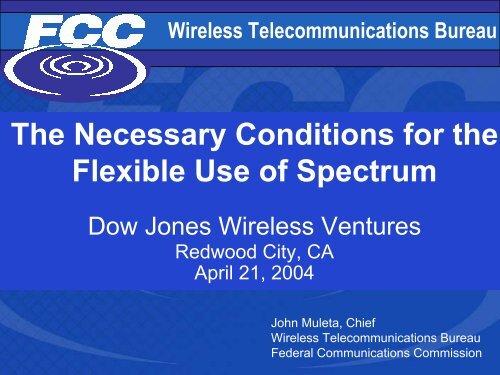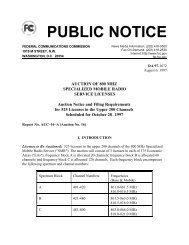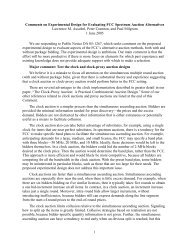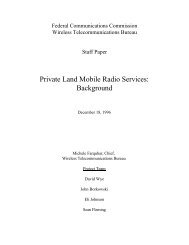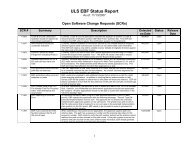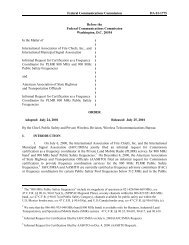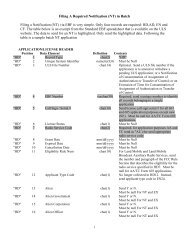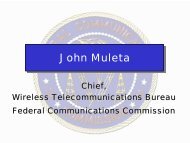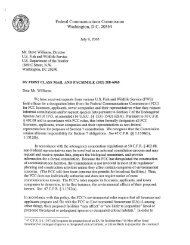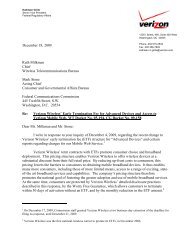The Necessary Conditions for the Flexible Use of Spectrum
The Necessary Conditions for the Flexible Use of Spectrum
The Necessary Conditions for the Flexible Use of Spectrum
Create successful ePaper yourself
Turn your PDF publications into a flip-book with our unique Google optimized e-Paper software.
Wireless Telecommunications Bureau<br />
Wireless Telecommunications Bureau<br />
<strong>The</strong> <strong>Necessary</strong> <strong>Conditions</strong> <strong>for</strong> <strong>the</strong><br />
<strong>Flexible</strong> <strong>Use</strong> <strong>of</strong> <strong>Spectrum</strong><br />
Dow Jones Wireless Ventures<br />
Redwood City, CA<br />
April 21, 2004<br />
John Muleta, Chief<br />
Wireless Telecommunications Bureau<br />
Federal Communications Commission<br />
1
Wireless Telecommunications Bureau<br />
Overview<br />
• FCC and Wireless Bureau’s <strong>Spectrum</strong><br />
Management Goals<br />
• Formula <strong>for</strong> Successful <strong>Spectrum</strong><br />
Management<br />
• What This Means For Wireless Investors<br />
2
Wireless Telecommunications Bureau<br />
<strong>Spectrum</strong> Management Goals<br />
TRANSPARENCY EFFICIENCY RELIABILITY<br />
• Promote highest and best use <strong>of</strong> spectrum and encourage growth<br />
and rapid deployment <strong>of</strong> innovative and efficient wireless<br />
technologies and services<br />
• Advance spectrum re<strong>for</strong>m by developing and implementing<br />
market-oriented allocation and assignment policies<br />
• Conduct effective and timely licensing activities that encourage<br />
efficient use <strong>of</strong> spectrum<br />
• Provide adequate spectrum <strong>for</strong> public safety and commercial<br />
purposes<br />
• Vigorously protect against harmful interference and en<strong>for</strong>ce public<br />
safety-related rules<br />
3
Wireless Telecommunications Bureau<br />
Wireless Bureau Objectives<br />
• Increase <strong>the</strong> consumer good to produce economic<br />
growth by <strong>the</strong> deployment <strong>of</strong> spectrum-based<br />
services<br />
• Foster US global competitiveness through <strong>the</strong> use<br />
<strong>of</strong> spectrum services<br />
• Greater emphasis on public safety and homeland<br />
security issues through <strong>the</strong> use <strong>of</strong> spectrum<br />
services<br />
• Focus on excellent customer service to benefit<br />
our licensees and consumers<br />
4
Provide access to<br />
new spectrum<br />
plat<strong>for</strong>ms<br />
Wireless Telecommunications Bureau<br />
<strong>Spectrum</strong> “Manager” Activities<br />
<strong>Spectrum</strong><br />
Access<br />
Policy<br />
<strong>Spectrum</strong><br />
Applications<br />
Outreach<br />
Rules<br />
Promote inter-modal<br />
convergence &<br />
competition<br />
<strong>Spectrum</strong><br />
Resources &<br />
Tools<br />
Consumer safeguard<br />
and public interest:<br />
• E911<br />
• Licensing Database<br />
• Auction Systems<br />
• LNP<br />
• CALEA<br />
5
Wireless Telecommunications Bureau<br />
<strong>Spectrum</strong> “Management” Success Story:<br />
<strong>The</strong> Mobile Wireless Story (1993-2003)<br />
• Subscribership grew from 16 to 160 million<br />
• Competitors increased from 2 to 7 or more in<br />
many markets<br />
• Prices dropped 80% or more<br />
• Minutes <strong>of</strong> <strong>Use</strong> increased 400%<br />
6
Wireless Telecommunications Bureau<br />
<strong>Spectrum</strong> “Management” Success Story:<br />
<strong>The</strong> Mobile Wireless Story (June 2002 - June 2003)<br />
152 Million<br />
Subscribers in<br />
2003<br />
UP<br />
13%<br />
From<br />
135<br />
Million<br />
Subscribers<br />
187,169 Jobs<br />
in 2003<br />
UP<br />
.1%<br />
From<br />
186,956<br />
Jobs<br />
Jobs<br />
$134 Billion<br />
Invested as<br />
<strong>of</strong> 2003<br />
UP<br />
13%<br />
From $118<br />
Billion<br />
Capital<br />
Investment<br />
Source: Cellular Telecommunications & Internet Association; FCC. Subscriber comparison uses CTIA<br />
estimate <strong>for</strong> June 2002 and FCC estimate <strong>for</strong> June 2003. June 2003 MOU estimate is preliminary.<br />
470 Average<br />
Monthly MOUs<br />
in 2003<br />
UP<br />
18%<br />
From 398<br />
MOUs<br />
Minutes<br />
<strong>of</strong> <strong>Use</strong><br />
Price<br />
per<br />
minute<br />
DOWN<br />
12%<br />
10.5 cents Per<br />
Minute in 2003<br />
7
Wireless Telecommunications Bureau<br />
Formula <strong>for</strong> Successful <strong>Spectrum</strong> Management<br />
(keeper slide)<br />
• Provide Flexibility (provides <strong>for</strong> efficient use)<br />
• Maximum technical and operational autonomy <strong>for</strong> licensees<br />
• Rapid transition <strong>of</strong> spectrum to highest and best uses using<br />
market <strong>for</strong>ces as much as possible<br />
• Ensure Competition (provides <strong>for</strong> effective use)<br />
• Intermodal/Intramodal competition<br />
• LNP, intercarrier compensation, universal service, public interest<br />
• CMRS, PCS, MSS/ATC, MVDDS, DBS versus local, long<br />
distance, radio, television, movies, ISPs<br />
• En<strong>for</strong>ce Opportunity Costs <strong>of</strong> Using <strong>Spectrum</strong> (provides market<br />
and economic discipline)<br />
• Auctions<br />
• Secondary Markets<br />
8
Wireless Telecommunications Bureau<br />
Upcoming Licensed <strong>Spectrum</strong> Opportunities<br />
• MDS/ITFS Band (2.5-2.69<br />
GHz)<br />
- Flexibility (√)<br />
- Competition (?)<br />
- Opportunity Cost (?)<br />
• 70/80/90 GHz<br />
- Flexibility (√)<br />
- Competition (?)<br />
- Opportunity Cost (?)<br />
• MVDDS<br />
- Flexibility (√)<br />
- Competition (√)<br />
- Opportunity Cost (√)<br />
• CMRS (Cellular, PCS, ESMR<br />
SMR)<br />
- Flexibility (√)<br />
- Competition (√)<br />
- Opportunity Cost (√)<br />
• 3G/AWS<br />
- Flexibility (√)<br />
- Competition (√)<br />
- Opportunity Cost (√)<br />
• 3650 MHz<br />
- Flexibility (√)<br />
- Competition (?)<br />
- Opportunity Cost (?)<br />
9
Telephone<br />
Traditional<br />
Communications<br />
World<br />
Apps.<br />
Interface<br />
Cellular/PCS<br />
Apps.<br />
Interface<br />
Cable<br />
Apps.<br />
Interface<br />
Wireless Telecommunications Bureau<br />
Wireless Investors<br />
Satellite<br />
Apps.<br />
Interface<br />
OSS OSS OSS OSS<br />
Copper <strong>Spectrum</strong> Coax <strong>Spectrum</strong><br />
Silos<br />
New World<br />
<strong>of</strong> Digital Migration<br />
Applications<br />
Operating Systems<br />
Plat<strong>for</strong>ms<br />
Layered<br />
10
Wireless Telecommunications Bureau<br />
Key Takeaways <strong>for</strong> Wireless Investors<br />
• Dedicated chips <strong>for</strong> DSP provides flexibility so spectrum<br />
will not be a scarce resource per se (e.g., cognitive<br />
radios, s<strong>of</strong>tware radios provide <strong>for</strong> more spectrum<br />
access)<br />
• Applications and CPE must be plug and play and must<br />
be digital and IP-centric<br />
• Operating system and support functions will be critical<br />
layer going <strong>for</strong>ward<br />
• All plat<strong>for</strong>ms will support all applications so target intermodal<br />
competition <strong>for</strong> growth (i.e., voice is just an<br />
application)<br />
11
Wireless Telecommunications Bureau<br />
Wireless Investment <strong>The</strong>sis<br />
• Invest in customers and customer control, all<br />
else being equal<br />
• Invest in applications that take share away from<br />
“old industries” (e.g., long distance, radio,<br />
television) that don’t have individualized<br />
customer relationships<br />
• Invest in unique, scaleable applications focused<br />
on above<br />
• Avoid OSS traps on plat<strong>for</strong>ms and avoid isolated<br />
plat<strong>for</strong>ms investments<br />
12
Wireless Telecommunications Bureau<br />
Conclusion<br />
Wireless meets <strong>the</strong> criteria <strong>for</strong> continued sector<br />
investment:<br />
• Technology is driving an increase in wireless capacity<br />
so it can compete with o<strong>the</strong>r plat<strong>for</strong>ms<br />
• Wireless has an ever-increasing number <strong>of</strong><br />
applications that are seamlessly available to it<br />
• Wireless has pre-existing level <strong>of</strong> high “individual” (not<br />
just household) subscriber penetration creating a<br />
scaleable environment<br />
13
Wireless Telecommunications Bureau<br />
Thank you!<br />
14


